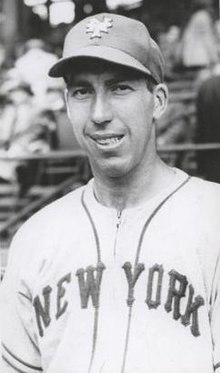Johnny Gee
| Johnny Gee | |||
|---|---|---|---|

Gee with the New York Giants, c. 1945
|
|||
| Pitcher | |||
|
Born: December 7, 1915 Syracuse, New York |
|||
|
Died: January 23, 1988 (aged 72) Cortland, New York |
|||
|
|||
| MLB debut | |||
| September 17, 1939, for the Pittsburgh Pirates | |||
| Last MLB appearance | |||
| September 26, 1946, for the New York Giants | |||
| MLB statistics | |||
| Win–loss record | 7–12 | ||
| Earned run average | 4.41 | ||
| Strikeouts | 65 | ||
| Teams | |||
John Alexander "Johnny" Gee, Jr. (December 7, 1915 – January 23, 1988), sometimes known as "Long John Gee" and "Whiz", was a professional baseball and basketball player.
Gee played Major League Baseball for the Pittsburgh Pirates from 1939 to 1944 and for the New York Giants from 1944 to 1946. In August 1939, he was one of the top pitching prospects in the minor leagues when he was purchased by the Pirates in exchange for $75,000 and four players – the highest price paid by the Pirates for a player until the purchase of Hank Greenberg in 1947. After suffering an injury to his throwing arm during spring training in 1940, his performance suffered, and he was sometimes referred to as the "$75,000 Lemon."
At six feet, nine inches, Gee was the tallest person to play Major League Baseball until Randy Johnson debuted for the Montreal Expos in September 1988. Gee also played professional basketball for the Syracuse Nationals. In November 1946, he became the leading scorer for the Nationals in their first home game and first win as a member of the National Basketball League.
Gee also played college baseball and basketball at the University of Michigan from 1935 to 1937. He was the captain of the 1936–37 Michigan Wolverines basketball team and struck out 21 batters in a June 1937 baseball game. He received the Big Ten Medal of Honor as the student in the Class of 1937 who had best demonstrated proficiency in both scholarship and athletics.
Gee was born in Syracuse, New York, in 1915. His parents were John Alexander Gee, Sr., and Anna Alvira (Nicholson) Gee. At the time of the 1920 U.S. Census, Gee was living with his parents and older sister Mildred in Syracuse's 13th Ward. His father was employed as a janitor at a school. Ten years later, at the time of the 1930 Census, the family remained in Syracuse, and Gee's father was employed as the superintendent of repairs for the city schools.
...
Wikipedia
